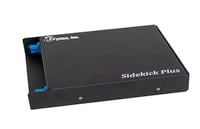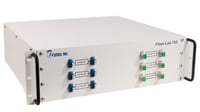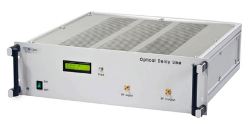There are several instances in communications applications where an Optical Delay Line (ODL) is used by a network operator. One may be necessary to account for delay differences between systems in an RF over Fiber (RFoF) type of setup, while others are necessary for signal timing synchronization, varying network service speeds, or to simulate expected delay in a test environment. In general, optical delay lines fall into two primary categories based on their construction – passive or active. In this article, we will briefly discuss the differences between the two as well as touch on some application examples.
Passive Optical Delay Lines
Just like the name implies, passive ODLs require no power and typically consist of a coil or spool of optical fiber that is wound and cut to a precise length in order to provide a specific time delay. Depending on the length and delay needed, these spools/coils are mounted inside an enclosure that can range from a very small portable module for short delays to larger rack-mount chassis for significantly longer delays.
 |
Passive ODL module with single delay coil |
 |
Passive ODL rack-mount with multiple delay coils |
In order to achieve the intended time delay, an ODL vendor must be able to wind a very precise length of fiber, which requires a significant investment into advanced, automated fiber spooling machinery and related testing devices and procedures. As a result of having these capabilities, most passive ODL solutions can be customized to the user’s exact requirements not only in terms of the delay/length, but also the fiber and connector type.
The expected precision of the time delay can vary by user and application requirement. For example, a telecom systems manufacturer or integrator may require less precision replicating a field link delay in the lab environment, as slightly a larger tolerance may be acceptable (ex: ensuring the actual delay will be as expected). However, for a low-latency financial or HFT network service provider that is deploying very specific time delays into the network, a much more precise delay and tighter tolerance is often necessary.
Active Optical Delay Lines
Active ODLs, on the other hand, are electronically powered devices that perform a conversion of an RF signal to optical and then output the signal again as RF. From a high level perspective, the device first converts an incoming analog RF signal into an optical signal. The optical signal is then transmitted through a single mode fiber coil of a specific length that provides a delay. After passing through the fiber coil, the signal is then converted back to an RF signal and output by the device.
To accomplish this process, active ODLs contain several components including lasers, photodiodes, optical modulators, and of course the single mode fiber coil. For more sophisticated applications along with extra capabilities like variable delays, other components such as optical switches, optical and RF amplifiers, and dispersion compensators may be integrated into the device. It is important to note that the total delay includes the combined delay of the fiber coil and the delay time for the signal to pass through the electronic components on both ends.
 |
Active Optical Delay Line |
What are some applications where an active optical delay line might be used? As noted in the introduction, RFoF communications systems often utilized in Defense and Military systems such as Radar, GPS, SATCOM, and Remote Antenna often require the inclusion of active ODL devices.
On a final note, due to the inclusion of extra hardware to achieve the necessary signal conversion and delay process, active ODL device often carry a significantly higher price tag than a passive ODL. However, the choice of whether to select an active ODL or a passive ODL should always be based on the specific application and project requirements.
Learn More / Design a Delay Line
Have a question or require a delay line for an upcoming project? Since 2001, M2 Optics has been an established leader in building fully customized ODL and packaged fiber coil solutions for Telecom, Defense, Financial, and Data Center applications. Whether you simply wish to learn more or need to start designing a new ODL setup configuration, M2’s experienced engineering team is available to provide support at your convenience.






